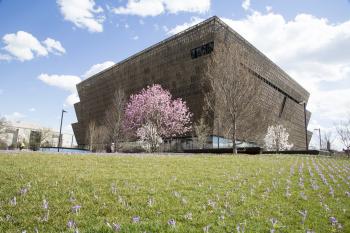![Unidentified African American soldier in Union uniform with wife and two daughters. Library of Congress Prints and Photographs Division Washington, D.C., AMB/TIN no. 5001 [P&P]. Unidentified African American soldier in Union uniform with wife and two daughters.](https://siarchives.si.edu/sites/default/files/styles/body-image-300/public/blog-attached-images/00400v.jpg?itok=jqw1zvdt) Smithsonian staff and Americans across the nation are making final preparations for the opening of the National Museum of African American History and Culture in just two days. Their work is the culmination of efforts to commemorate African American history on the National Mall that began over 100 years ago. While those early efforts did not come to fruition, their work many generations ago laid the foundation that these upcoming opening celebrations rest on.
Smithsonian staff and Americans across the nation are making final preparations for the opening of the National Museum of African American History and Culture in just two days. Their work is the culmination of efforts to commemorate African American history on the National Mall that began over 100 years ago. While those early efforts did not come to fruition, their work many generations ago laid the foundation that these upcoming opening celebrations rest on.
The first men and women to advocate for the commemoration for African American contributions to American history knew well the significance of telling this story in the nation’s front yard. They were African American veterans of the Civil War, members of the nearly 180,000 U.S. Colored Troops who put their lives at risk for a nation that did not grant them equality under the law. At the end of the Civil War, the victory parade through Washington, D.C., the Grand Review Parade, excluded U.S. Colored Troops and denied them the recognition and applause they earned serving their country. Fifty years later, in 1915, another Grand Review Parade celebrated the anniversary and African American veterans were determined to participate. U.S. Colored Troop veterans formed a Committee of Colored Citizens of the Grand Army of the Republic to support African American participation in the parade. The committee provided help with housing, food, and logistical costs for veterans who were coming to D.C. to march in the parade, but, importantly for us, after the parade they used the leftover funds to set up a National Memorial Association to create a more permanent memorial to African Americans’ military contributions.
![The Grand Review of the Army. Gen. Horatio G. Wright, staff and 6th Corps passing on Pennsylvania Avenue near the Treasury, May 1865, By Matthew Brady, glass negative, Library of Congress, LC-B811- 3316 [P&P] LOT 4198. The Grand Review of the Army.](https://siarchives.si.edu/sites/default/files/styles/body-image-300/public/blog-attached-images/02807v.jpg?itok=EyCXawY0)
 Within this National Memorial Association, the proposal to create a memorial building soon evolved into a building housing a National African American Museum to commemorate African Americans’ “contribution to America in the military service, in art, literature, invention, science, industry, etc.” (70th Cong., 1st sess. H. Rept. 353. 1928. Accompanying H. J. Res. 60). This museum would also be an educational center, giving inspiration and pride to future generations by the example of those who have contributed to the advancement of the nation. Despite significant grassroots support, congressional opposition made an authorizing law for a commission to construct the museum a nearly impossible goal. Yet, fourteen years later on March 4, 1929 an authorizing law, Public Law 107, was signed by President Calvin Coolidge. However, timing was not on their side. The law was passed with no guaranteed funding and just seven months later the stock market crash of October 1929 presented a major setback for the Commission.
Within this National Memorial Association, the proposal to create a memorial building soon evolved into a building housing a National African American Museum to commemorate African Americans’ “contribution to America in the military service, in art, literature, invention, science, industry, etc.” (70th Cong., 1st sess. H. Rept. 353. 1928. Accompanying H. J. Res. 60). This museum would also be an educational center, giving inspiration and pride to future generations by the example of those who have contributed to the advancement of the nation. Despite significant grassroots support, congressional opposition made an authorizing law for a commission to construct the museum a nearly impossible goal. Yet, fourteen years later on March 4, 1929 an authorizing law, Public Law 107, was signed by President Calvin Coolidge. However, timing was not on their side. The law was passed with no guaranteed funding and just seven months later the stock market crash of October 1929 presented a major setback for the Commission.
Seventy four years later in 2003 Congress again authorized the building of a National African American Museum. This time, momentum gathered rather than waned, and now, thirteen years after that it is finally about to open. As we celebrate this achievement and all it represents, let’s take a moment and remember the men and women of the National Memorial Association, Committee of Colored Citizens of the Grand Army of the Republic, and the US Colored Troops who shared this vision of the importance and power that this museum holds.

Learn more about the incredible history of the National Museum of African American History and Culture on our updated history page.
Related Resources
- U.S. Colored Troops History, African American Civil War Memorial and Museum
- “A Place of our Own: The National Museum of African American History and Culture," Howard Dodson. Callaloo Vol. 38, No. 4 (2015) 729-741.
Produced by the Smithsonian Institution Archives. For copyright questions, please see the Terms of Use.

Leave a Comment